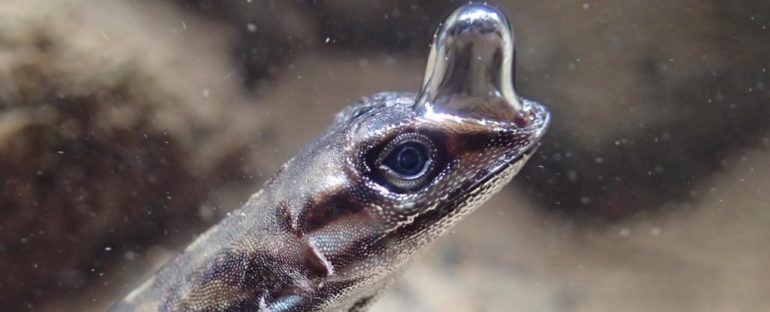From the waters we creatures of the land emerged. Some animals, like whales, returned to it. Others, like frogs, never truly let go of their watery origins, and even now we’re still discovering clever ways in which terrestrial creatures can find refuge within this soothing liquid medium.
Case in point: air-breathing anoles have developed a neat trick to take down air with them when they flee to the water to escape predators.
“Many lizards dive in response to threats and some will endure extreme hypoxia before resurfacing in the presence of a perceived predator,” evolutionary biologist Chris Boccia from Queen’s University and his team explain in their new paper.
Just how anoles could remain underwater for as long as 18 minutes, however, is something that puzzled biologists.
“Finding evidence suggesting that water anoles ‘breathe’ under water was serendipitous, and not part of my original research plan,” behavioral ecologist Lindsey Swierk from Binghamton University told Matthew Russell for The Rainforest Site.
“I was impressed and pretty confused about the length of the dive, which gave me an itch to take a closer look with an underwater camera in the next couple of years.”
That’s how Swierk spied air bubbles forming on the anoles’ mini shining snouts while they were submerged.
An underwater peek at our quirky Anolis aquaticus … just look at those lizard LIPS 💋 ! #lizardprince #herpetology #puravida pic.twitter.com/HzLLF60hYB
— Dr. Lindsey Swierk (@LindseySwierk) June 29, 2019
“Semi-aquatic anoles exhale air into a bubble that clings to their skin,” explained Boccia. “The lizards then re-inhale the air, a maneuver we’ve termed ‘rebreathing’ after the scuba-diving technology.”
Diving insects like the river bug (Aphelocheirus aestivalis) are known to breathe beneath the water using air bubbles, and some spiders even use an abdominal bubble to live within this liquid.
But the discovery of underwater rebreathing lizards was unexpected, the team explained, because vertebrates have much higher metabolic rates, are generally larger, and therefore have a smaller surface area to body ratio, so they require more oxygen.
What’s up with that bubble?
Check out what we found! 🦎🌊🦎https://t.co/sQrfxgJgjX@cboccia22 @Luke_Mahler @AMartinology #anole #herpetology #scicomm #HERper pic.twitter.com/P1PxgIYCrf— Dr. Lindsey Swierk (@LindseySwierk) May 14, 2021
“It’s easy to imagine the advantage that these small, slow anoles gain by hiding from their predators underwater – they’re really hard to spot!” said Swierk. “But the real question is how they’re managing to stay underwater for so long.”
Water-repelling scales appear to hold the air bubble in place over the iguana relative’s little nostrils. The team measured the oxygen levels in these petite, portable air pockets and observed them drop over time. This suggests the anoles are indeed using this technique to breathe underwater.
The researchers speculate the ‘scuba’ bubble could work in several ways. It may allow the anoles to redirect the oxygen-filled air from the ‘dead space’ within their bodies, such as their nose and mouth cavities, towards their lungs, or from the thin layer of air that forms across their skin when they’re enveloped in water, called a plastron.
They might also be using this bubble to help them expel excess carbon dioxide, which shortens the ability of some reptiles to hold their breath. Or it could be possible that the reptiles use the bubble to pull in more oxygen from the water via diffusion, the team suggests.
This sustained rebreathing trait was found in five groups of anoles that aren’t directly related to each other, but all are semi-aquatic species – suggesting this behavior provides a strong survival advantage for these tiny lizards who stick close to water sources. However, a non-aquatic anole species appeared to only have rudimentary bubble-breathing skills.
Several anole species dine on aquatic delicacies, including small fish and crustaceans, so perhaps this bubble-breathing behavior also aids their visual hunts too.
Over 400 anole species of myriad sizes and colors live throughout the world’s tropics. Their unique features include absurdly flamboyant neck flaps called dewlaps and the male’s gaping bite-fights.
Now we can also add rebreathing to their repertoire of the strange.
This research was published in Current Biology.



